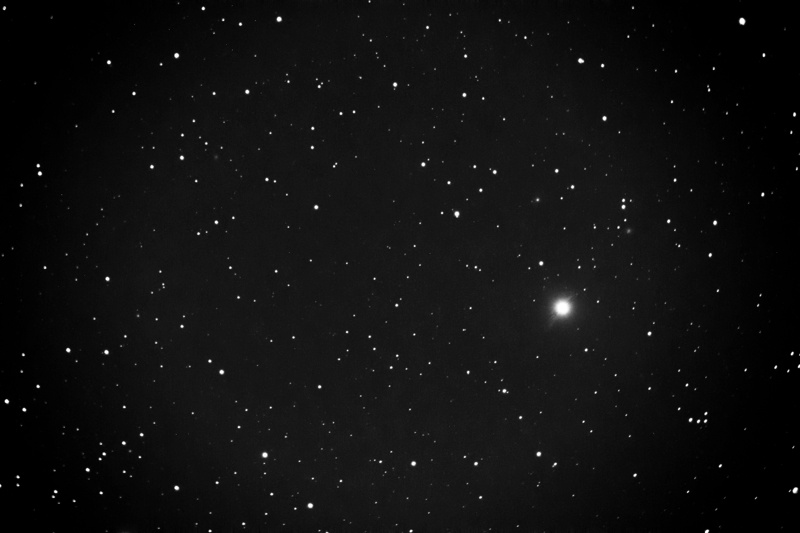Jupiter, Cat's Eye Nebula,
Near Earth Object Asteroid 2014 JO25 (bust)
Posted: 19 April 2017
Sunday, 16 April 2017, was mostly cloudy and windy. Missed a ISS good pass that night. Monday, 17 April, the sky continued mostly cloudy. Tuesday, 18 April, dawned clear and calm, giving hope that I would be able to get some images of the very close pass of Near Earth Object (NEO) asteroid 2014 JO25 early Wednesday morning.
Asteroid 2014 JO25 was discovered in May 2014 by astronomers at the Catalina Sky Survey on Mt Lemmon (11 miles south of Cassiopeia Observatory). I and several other members of the Oracle Dark Skies Committee were treated to a special visit to Mt Lemmon Observatory a year later in recognition of getting Oracle State Park designated as an IDA "International Dark Sky Park". Asteroid 2014 JO25 is about 0.8 miles in diameter (about twice as large as initially thought based on new observations taken on 17 April 2017 from the Arecibo Observatory Planetary Radar System) and would approach the Earth to about a million miles away (only four times further than the Earth's Moon) at 0524 MST Wednesday morning, 19 April. It would be visible all night long Tuesday-Wednesday, providing an excellent opportunity to try to capture some images of this rapidly moving asteroid on my 1100th session at Cassiopeia Observatory.
|
Open: Tuesday, 18 April 2017, 1819 MST Temperature: 91°F |
Session: 1100 Conditions: Clear |
Equipment Used:
12" f/8 LX600 w/StarLock
2" 24mm UWA eyepiece
Camera:
iPhone 6s Plus
D7200 DSLR
First I SYNCed the observatory clock and DSLR to WWV. Then I did some organizing of some papers I keep in the observatory.
1837 MST: winds picked up. I began relaxing on the observatory patio bench while waiting for sunset.
1857 MST: sunset. Prepared the D7200 DSLR for prime focus imaging. Then returned to the bench. 1910 MST: winds had calmed down.
1923 MST: LX600 ON, StarLock OFF, High Precision OFF.
1925 MST: viewed Jupiter, 102X, through a tree. Three moons were visible. Began waiting for the end of Astronomical Twilight, which would be at 2023 MST. Returned to the bench to "watch the stars come out".
1956 MST: did some more Jupiter observing, 102X. I could now see the shadow of the moon Io on the planet. Grabbed this quick iPhone 6s Plus handheld afocal 102X photo using NightCap Pro (ISO 50, 1/70sec):

The shadow of Io is just right of the center of the North Equatorial Belt. The moon Europa is to the left of the planet's disk.
2015 MST: the Zodiacal Light was nicely visible in the western sky.
2020 MST: slewed to NGC6543 (Cat's Eye Nebula, planetary nebula), which would be the first DSLR imaging target once it was higher in the sky. Asteroid 2014 JO25 was still even lower in the northern sky. SYNCed the AutoStar on NGC6543.
2100 MST: Wi-Fi ON. Using SkySafari 5 Pro did a GOTO asteroid 2014 JO25 for a first attempt to view the faint asteroid. It was still low in the sky. 2150 MST: had no luck in seeing any moving object even though I kept GOTOing the asteroid as it was rapidly moving. Wi-Fi OFF.
Mounted the D7200 DSLR at prime focus of the 12" telescope, focused on the star Kocab, and locked the mirror. 2202 MST: StarLock ON. Began imaging NGC6543 at prime focus. Although the Cat's Eye Nebula was still somewhat low in the sky, this is a cropped 5 seconds, ISO 800, White Balance 3570K image:

I plan to re-image NGC6543 (Cat's Eye Nebula) on a future session.
Removed the camera from the 12" telescope.
2223 MST: Wi-Fi ON. Used SkySafari to GOTO asteroid 2014 JO25. Still no luck observing the asteroid, 102X. 2314 MST: Wi-Fi OFF. Took a short break.
2330 MST: returned to the observatory and began preparing to try to image the asteroid. Mounted the DSLR at prime focus + focal reducer, SYNCed and focused on the star Vega, locked the primary mirror. 2336 MST: Wi-Fi ON, GOTO asteroid 2014 JO25 using SkySafari. StarLock ON. Began imaging the "position" of the asteroid using various exposure lengths.
Over the next few hours I did many exposures of 1, 2, and 5 minutes, at ISO 3200, 6400, and 12800, each time re-GOTOing the asteroid. I did images a few minutes apart without slewing the telescope and tried "blinking" the images on the DSLR screen to look for any moving object. Never saw any moving object. With the rapid motion of the asteroid across the sky a trailed object should have been evident in the 5 minute exposures, but nothing was seen. As the asteroid became higher in the sky I SYNCed on the star Gamma Draconis. Still no asteroid seen in the images. 0217 MST: this full-frame black-n-white image, 5 minutes, ISO 12800, should show a trailed asteroid, but nothing is visible:

0223 MST: StarLock OFF. Ended imaging attempts as the waning Moon (near Last Quarter) was rising over the hill to the southeast. Either the asteroid was too faint to image, especially with the brightening sky, or SkySafari 5 Pro was not accurately showing the asteroid's position. I had updated the minor planet data in the app so it should have shown correctly.
0249 MST: viewed the Moon, 102X, through the tree. Then viewed Saturn and some of its moons, 102X.
0255 MST: LX600 OFF.
|
Close: Tuesday, 18 April 2017, 0304 MST Temperature: 60°F |
Session Length: 8h 45m Conditions: Clear |
Comments are welcome using Email. Twitter users can use the button below to tweet this report to your followers. Thanks.
Cassiopeia Observatory Home Page
Copyright ©2017 Michael L. Weasner / mweasner@me.com
URL = http://www.weasner.com/co/Reports/2017/04/19/index.html
